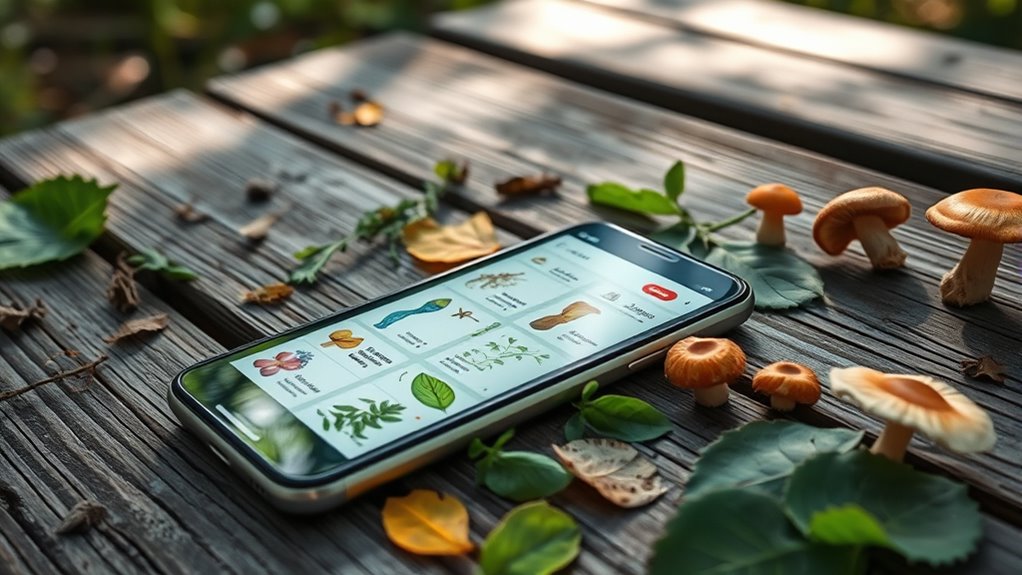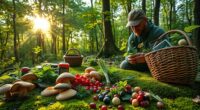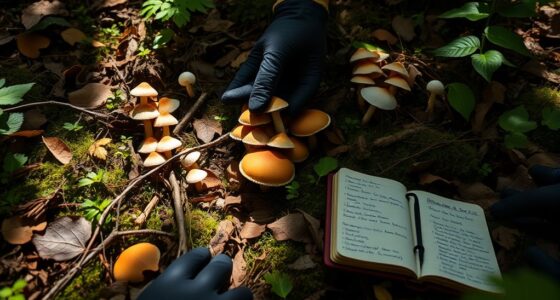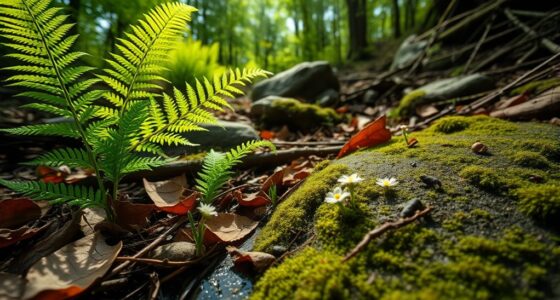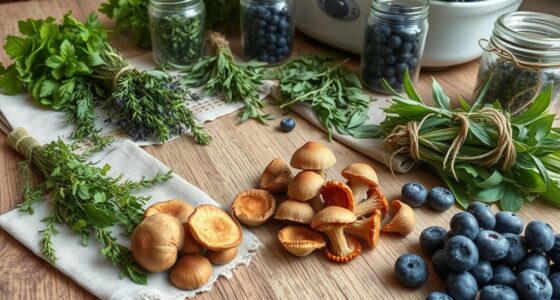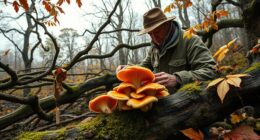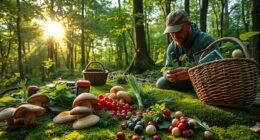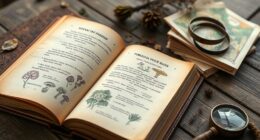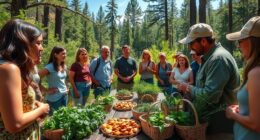To enhance your foraging journey, use apps like iNaturalist, PlantSnap, and PictureThis for accurate plant identification, even offline. Explore digital resources such as Pl@ntNet and online forums to deepen your knowledge, while AI tools like MushroomAI provide safety tips for fungi. Join online communities, courses, and local groups to learn sustainable practices and improve your skills. Keep exploring these tools, and you’ll discover even more ways to forage responsibly and confidently.
Key Takeaways
- Plant identification apps like iNaturalist, PlantSnap, and PictureThis assist users in accurately recognizing wild plants and ensuring safety.
- Digital recognition tools such as Pl@ntNet and PlantTAGG use AI and machine learning for detailed plant identification and habitat info.
- Online platforms, forums, and social media groups facilitate community sharing, expert advice, and regional foraging resources.
- Educational websites, YouTube channels, and online courses provide structured learning on sustainable and safe foraging practices.
- Apps with offline capabilities and community features enhance foraging in remote areas and promote responsible harvesting.
Popular Identification Apps for Foragers
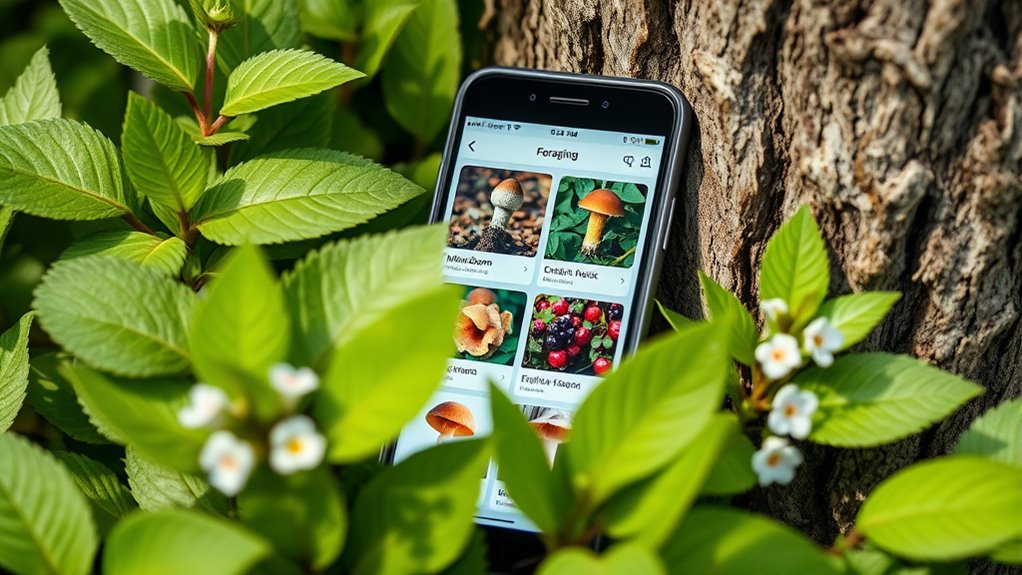
When it comes to identifying wild plants, several apps stand out as valuable tools for foragers. iNaturalist relies on community input and expert validation, making it a trusted source for accurate identifications.
PlantSnap uses AI to quickly recognize plants, with a vast database of over 600,000 species, and it even offers an offline mode for remote areas.
PictureThis provides detailed profiles with multiple photos at different growth stages, helping you understand each plant better.
Wild Edibles focuses on edible and medicinal plants, offering habitat and description info to aid accurate identification.
Utilizing these apps can also help you ensure safety by confirming plant identities before consumption or collection. These apps enhance your foraging experience by providing reliable, easy-to-use tools to confirm plant identities, ensuring safety and success in the wild.
Digital Resources for Plant Recognition
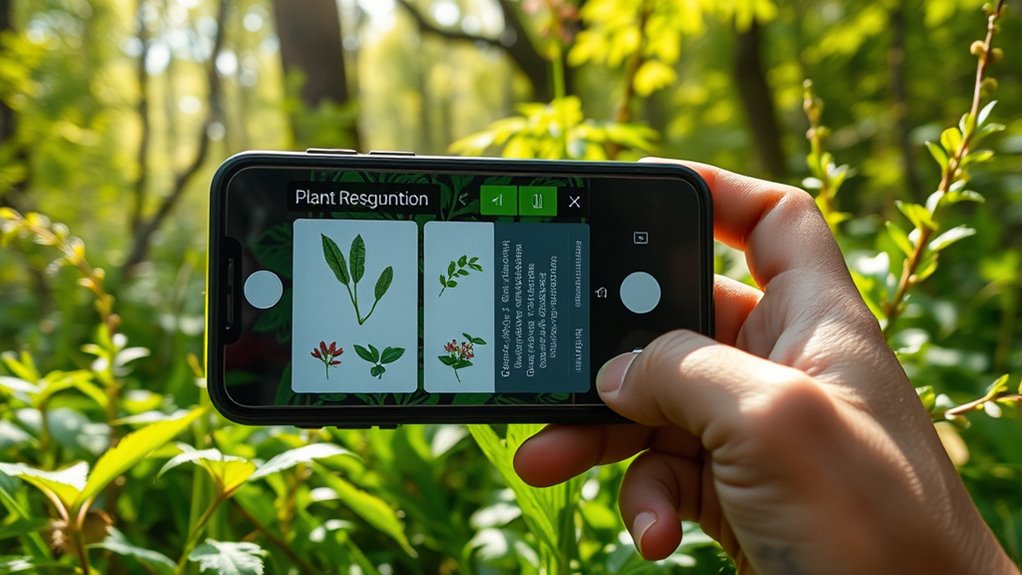
Digital resources for plant recognition have revolutionized how foragers and botanists identify and study plants. Tools like Pl@ntNet and PlantTAGG use advanced image recognition to provide accurate identifications with detailed profiles. Online forums and discussion groups allow you to share observations and receive expert feedback quickly. Traditional illustrated field guides remain useful and are often used alongside digital options. Botanical databases, peer-reviewed journals, and plant conservation websites deepen your understanding of plant species and their importance. The use of image recognition technology powered by machine learning and deep learning models continuously improves accuracy. Community-driven platforms and crowdsourced data further enhance these tools, making plant identification faster, more reliable, and accessible to everyone. Additionally, plant taxonomy resources help users understand the classification and relationships between different species, enriching the overall identification process. Incorporating digital tools into your practice can significantly increase the efficiency and accuracy of plant identification efforts. Moreover, the integration of user-generated data enhances the robustness of these platforms, leading to more comprehensive plant databases. A focus on lifestyle habits can also improve your ability to observe and correctly identify plants in various environments.
Enhancing Foraging With AI and Smartphone Technology
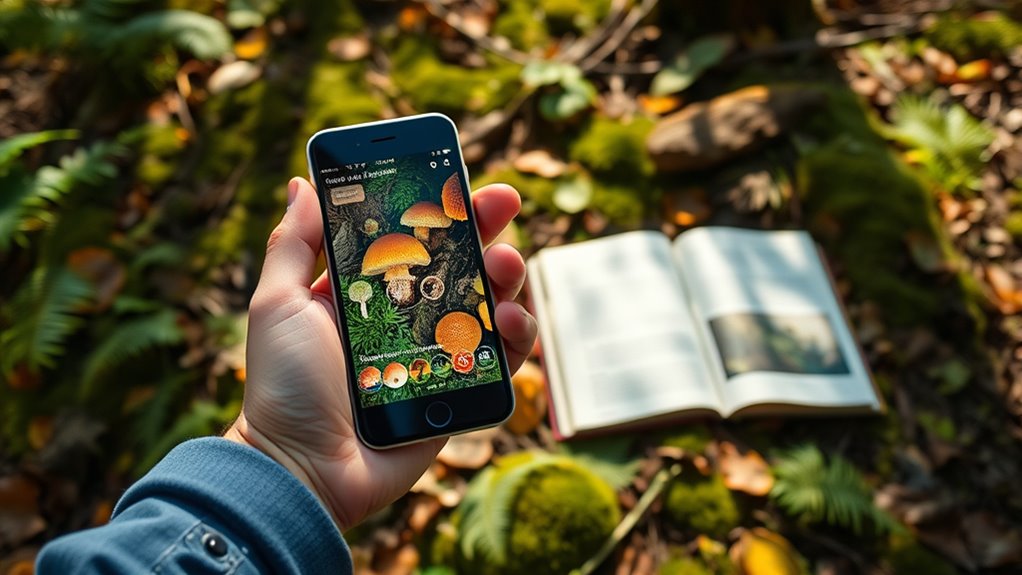
AI and smartphone technology are transforming how foragers identify and gather wild foods by providing instant, accurate assistance in the field. Apps like MushroomAI use AI-driven image analysis to identify fungi, offering detailed classifications and safety tips.
Meanwhile, tools like PlantSnap can identify plants offline, even in remote areas, thanks to extensive databases of over 600,000 species. These apps also deliver educational content about habitat, growth, and edibility, helping you make informed decisions. The integration of foraging range considerations into these apps can help users understand the typical distances bees and other pollinators travel, thereby enhancing ecosystem awareness.
AI-powered photo analysis guarantees quick, precise identifications, reducing risks from poisonous lookalikes. Community features allow you to share discoveries and learn from others’ experiences, enhancing safety and knowledge. Incorporating personal development principles can boost confidence and motivation during foraging adventures. Additionally, incorporating safety protocols within these tools can further improve user protection and decision-making.
Continuous AI improvements increase accuracy, making foraging safer, more efficient, and more enjoyable. User engagement features further support learners by allowing them to track their foraging journeys and receive personalized recommendations.
Essential Online Platforms and Communities
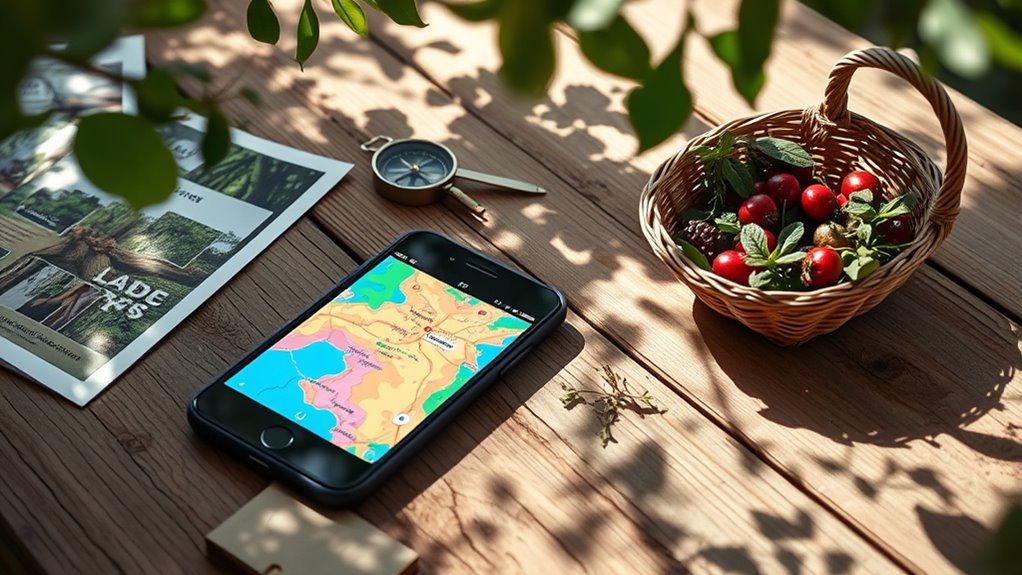
Online platforms and communities play a pivotal role in supporting foragers by providing accessible resources, expert guidance, and opportunities for connection. Websites like Rachel Lambert’s and Robin Harford’s offer recipes, guides, podcasts, and essays that deepen your understanding of wild foods, whether you’re a beginner or experienced forager. Incorporating cybersecurity measures into your online activity helps protect your personal information and ensures a safe browsing experience.
Platforms such as Forager Ltd and the Scottish Fungi Groups provide identification tools, regional meet-ups, and educational content to enhance your skills safely. Engaging with community-based resources fosters a sense of shared knowledge and responsibility among enthusiasts worldwide. Social media groups on Facebook, Reddit, and Discord foster real-time sharing, advice, and camaraderie among enthusiasts worldwide. Additionally, staying informed about textile art trends can inspire your foraging-related crafts and sustainable practices. Being aware of small mistakes, big impact in your online activities can help you avoid errors that compromise your safety or privacy.
YouTube channels and Meetup.com help you learn through videos and local events, building a strong community that encourages sustainable practices and continuous learning in your foraging journey. Incorporating state-specific regulations into your knowledge ensures responsible foraging practices and helps you stay compliant with local laws.
Tools for Sustainable and Safe Foraging
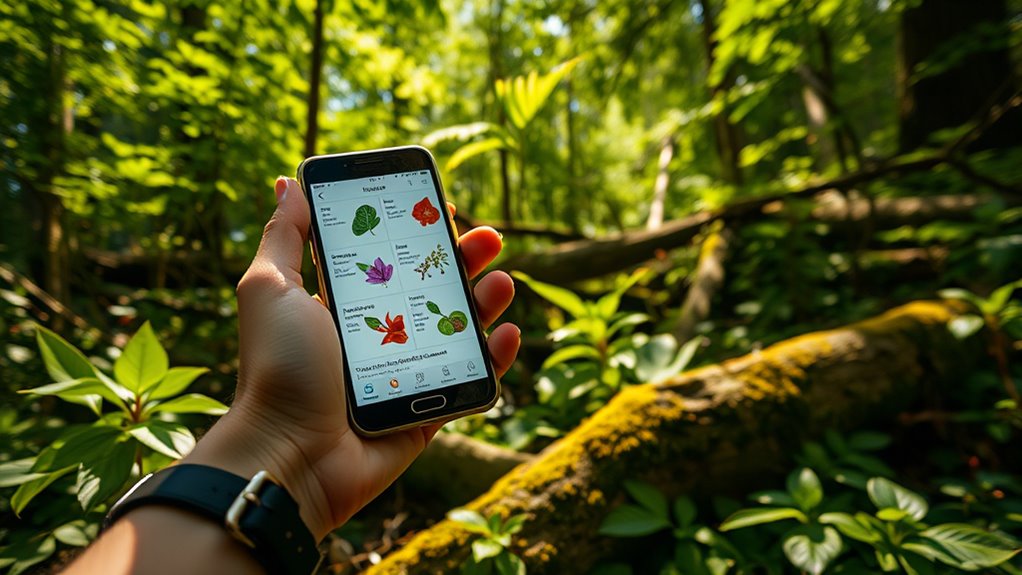
To guarantee your foraging is both safe and sustainable, it’s essential to utilize effective tools and resources that guide responsible harvesting. Use sustainable foraging guides to assess plant populations, focusing on abundant, widespread species to prevent overharvesting. Incorporating knowledge about raw food and its principles can also help identify edible and nutritious plants in the wild. Additionally, utilizing local foraging groups and workshops can enhance your understanding of regional ecosystems and sustainable practices. Embracing ecosystem awareness ensures you are mindful of the broader environmental impact of your foraging activities. Favor non-native plants when appropriate, but always consider environmental impacts. Consult organizations like *United Plant Savers* to identify at-risk species and avoid ecosystems under high habitat pressure. Ensure accurate plant identification with reliable apps or field guides to prevent poisoning. Check local regulations and permit requirements before harvesting, especially on private land, and avoid polluted or industrial areas. Follow legal and ethical guidelines by respecting property rights and minimizing ecological impact. These tools help you forage responsibly while protecting ecosystems and yourself.
Educational Platforms and Courses for Foraging Skills
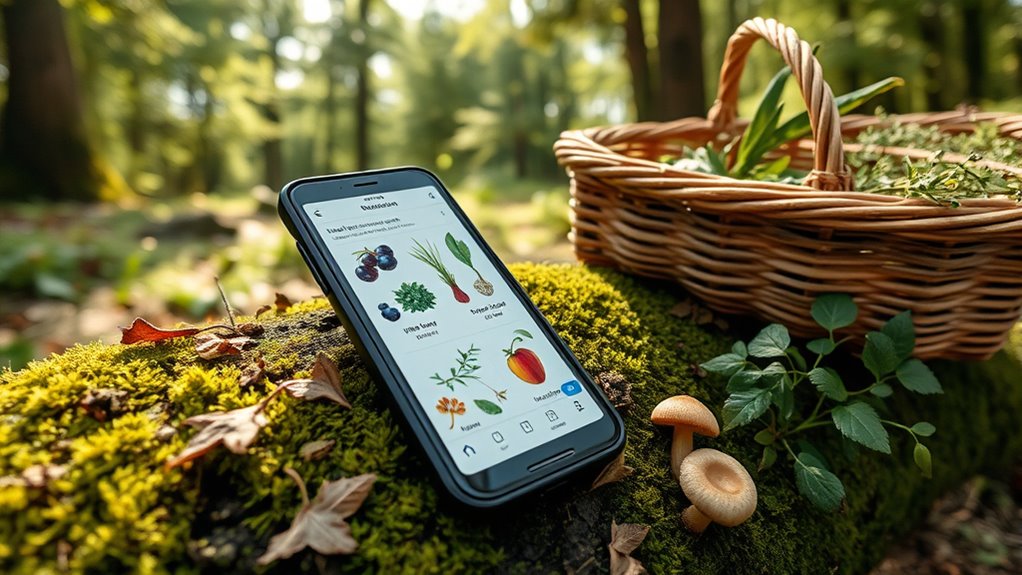
Educational platforms and courses for foraging skills offer structured, interactive learning experiences that help you develop confidence and competence.
Foraging 101 provides a module-based online course with seven monthly sections covering everything from basic identification to advanced harvesting techniques. Each module features video lessons, plant identification videos, reading materials, quizzes, scavenger hunts, and discussion forums, making learning engaging and practical. A new sentence emphasizes the importance of sustainable harvesting practices to ensure the long-term availability of wild plants while respecting natural ecosystems. Incorporating essential oil knowledge can also deepen your understanding of plant properties and safe usage. Additionally, understanding ethical foraging principles encourages responsible collection that benefits ecosystems and future foragers. To enhance your learning experience, the course also includes guidance on foraging safety to prevent hazards and promote responsible practices.
The course emphasizes safety, sustainability, and tracking progress through a foraging journal. It’s designed for a 2-3 hour weekly commitment, with flexible pricing options including individual modules or the full package. Additionally, instructor training programs teach you how to lead foraging walks, covering site planning, safety, and teaching skills. Developing Cultural Intelligence can also enhance your understanding of different plant uses and traditional knowledge systems, enriching your foraging practice.
Such platforms empower you to become a confident, independent forager and educator.
Frequently Asked Questions
How Accurate Are Plant Identification Apps Compared to Expert Identification?
You wonder how accurate plant identification apps are compared to experts. Usually, these apps correctly identify plants about 69% of the time, with some like PictureThis reaching up to 96%.
While apps are helpful for quick guesses, experts still outperform them by considering environmental clues and plant details.
For critical identifications, especially with rare or tricky plants, consulting an expert remains the safest choice.
Are There Specific Apps for Foraging in Urban Environments?
You want to know if there are apps designed for urban foraging. Yes, several apps cater specifically to city environments, like Falling Fruit, which maps edible plants and fruit trees in urban areas.
RipeNearMe helps you find, share, and trade foraged foods locally. These apps offer interactive maps, species info, and community features to make urban foraging easier, safer, and more social.
Can Online Tools Help Identify Medicinal Properties of Wild Plants?
Think of online tools as your trusty compass while exploring wild plants. They can help you identify medicinal properties, much like a guide revealing hidden treasures.
For example, the Medicinal Plant Identifier claims over 90% accuracy, helping you confidently discover plants with healing virtues.
These tools connect you with experts and communities, making your foraging safer and more informed, turning nature’s pharmacy into your personal wellness resource.
What Privacy Considerations Exist When Using Foraging Apps With Location Data?
When you use foraging apps with location data, you need to contemplate privacy risks like continuous tracking, which can reveal your movements and specific foraging spots.
Granting “always-on” permissions exposes your location even when you’re not actively using the app.
Sharing location data publicly or without controls can lead to overharvesting or privacy breaches.
Always review privacy policies, manage permissions, and be cautious about sharing sensitive location information.
How Often Are Plant Databases Updated in These Digital Resources?
Think of plant databases as a well-oiled machine, constantly evolving. These resources are updated regularly—some monthly, others more frequently—thanks to API integrations and user feedback.
You can count on the data being fresh and reliable, though occasional challenges may slow updates. Overall, developers keep the information current so you can forage confidently, knowing you’re working with the latest data available.
Conclusion
With over 80% of foragers now relying on apps and online tools, technology has transformed how you discover and identify wild edibles. These resources boost your confidence and safety, making foraging more accessible and sustainable. Embrace the digital age to connect with expert communities and hone your skills. By using these tools responsibly, you help sustain natural habitats and ensure safe, enjoyable foraging experiences for years to come.

